Table of Contents
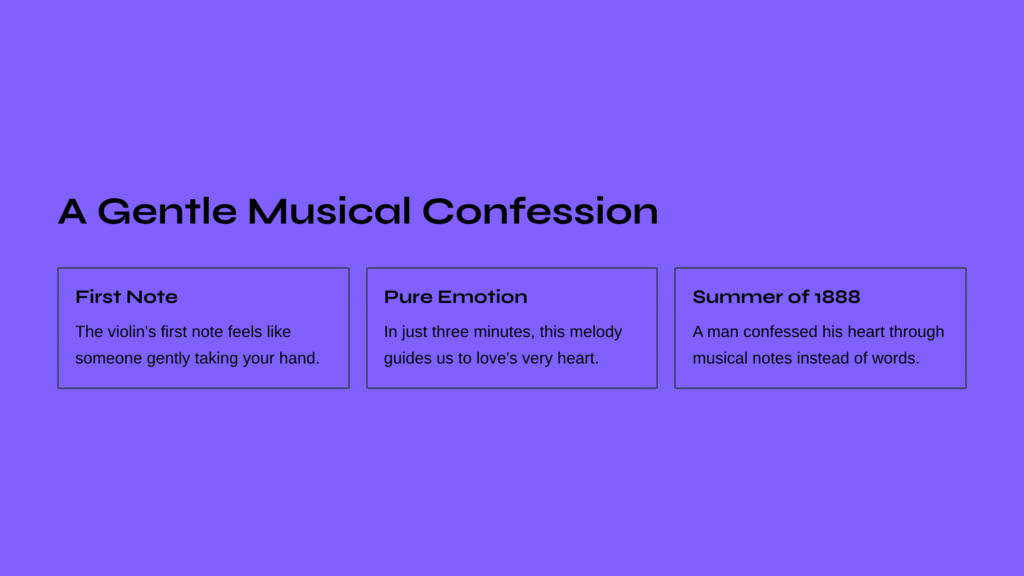
A Single Teardrop on the First Page of Sheet Music
Close your eyes and listen carefully. The moment the violin tentatively draws its first note, doesn’t it feel like someone is gently taking your hand? Edward Elgar’s Salut d’Amour is precisely that kind of music. In just three minutes, this small gem of a melody guides us to the very heart of love—humanity’s most pure emotion.
On a summer day in 1888, a man picked up his pen to dedicate something to the woman he loved. Instead of flowery words or grand promises, he confessed his heart through musical notes. That this confession continues to touch hearts around the world to this day is nothing short of miraculous.
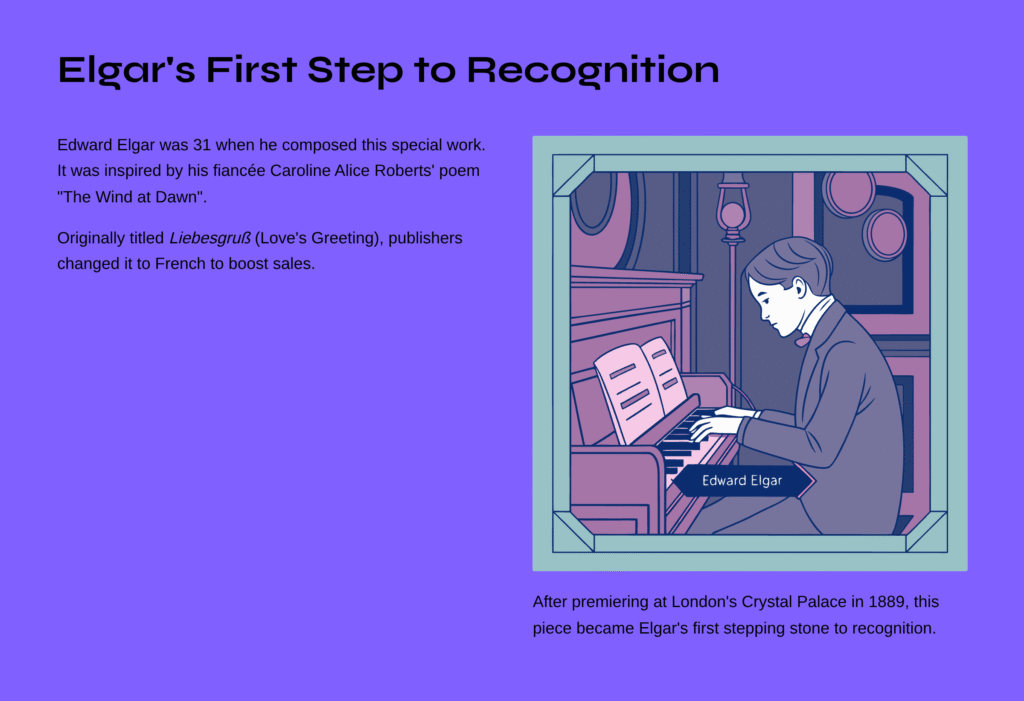
A Letter Written in Love, Elgar’s First Step
Edward Elgar was 31 when he composed Salut d’Amour. Still a relatively unknown composer, this work held special significance for him. Inspired by a poem “The Wind at Dawn” written by his fiancée Caroline Alice Roberts, he originally titled it Liebesgruß in German, meaning “Love’s Greeting.”
What’s fascinating is that the piece initially received little attention. The publisher even changed the title to the more sophisticated French Salut d’Amour to boost sales. But music written with genuine emotion ultimately proves its worth through time. After the orchestral version premiered at London’s Crystal Palace in 1889, this work became Elgar’s first stepping stone to recognition.
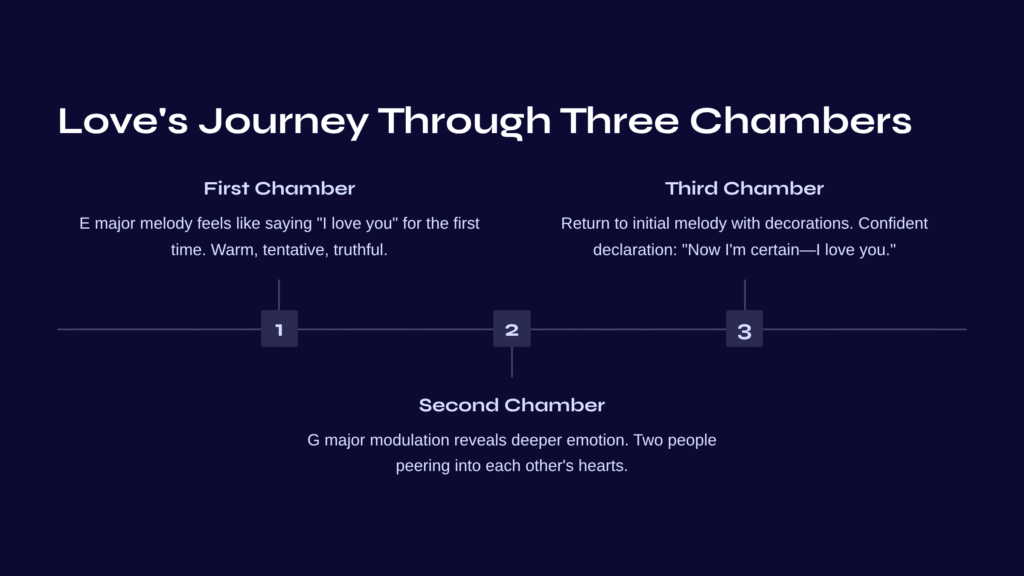
Love’s Fragrance Blooming Through Three Chambers
Salut d’Amour has a structure like wandering through three rooms of a beautiful house. Musicologically, it’s an A-B-A’ ternary form, but understanding it as an emotional journey is far more meaningful than such rigid analysis.
First Chamber: The Tentative Beginning of Confession
The opening melody in E major, bathed in warm sunlight, feels like the trembling before saying “I love you” for the first time to someone special. The violin sings the theme slowly yet confidently over the piano’s gentle accompaniment. This melody contains hesitation, excitement, and above all, a truthful heart.
Second Chamber: Exploring the Depths of Emotion
The middle section shifts the atmosphere slightly. The modulation to G major seems to reveal another facet of love—something more dramatic, more earnest. Whenever I hear this section, I imagine two people peering into the deepest corners of each other’s hearts.
Third Chamber: Decorated Recapitulation and Eternal Promise
We return to the initial melody, but now adorned with beautiful sixteenth-note decorations. It feels confident, as if declaring “Now I’m certain—I love you.” In the final coda, all emotions converge into a perfect conclusion.

Three Minutes of Miracle That Touched My Soul
I still vividly remember hearing this piece for the first time. The moment the violin’s opening melody began to flow, my eyes welled up with tears for reasons I couldn’t explain. There was no flashy virtuosity, no grand scale—just pure, honest emotion overflowing.
Perhaps the greatest power of this music lies in its “authenticity.” Elgar wasn’t trying to impress anyone here. He simply wanted to convey his heart to someone he loved. That pure intention transcends time and space, reaching us today just as clearly.
Especially when the melody rises slightly in the middle section, it feels like emphasizing “I truly love you” once more. The urgency of that moment touches my heart directly, making me wonder if I’ve ever loved someone this purely myself.
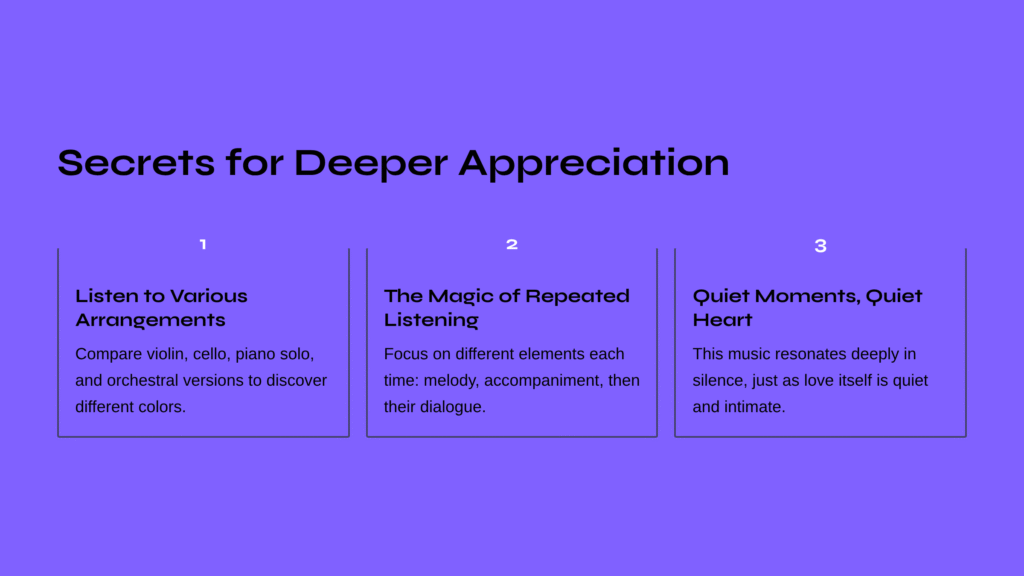
Small Secrets for Deeper Appreciation
First Tip: Listen to Various Arrangements
While Salut d’Amour was originally written for violin and piano, it exists in cello, piano solo, and orchestral versions. Each has its own charm, so comparing how the same melody takes on different colors through different instruments is genuinely delightful.
Second Tip: The Magic of Repeated Listening
Though only three minutes long, this piece reveals new aspects with each listening. If you focused only on the main melody initially, try listening to the piano accompaniment’s subtlety the second time, then the dialogue between the two instruments the third time. It’s like discovering new aspects of your partner as love deepens.
Third Tip: In Quiet Moments, with a Quiet Heart
This music resonates more deeply when heard in a quiet space with an empty mind, rather than through fancy speakers at high volume. Just as love itself is quiet and intimate, this music shines brightest in silence.
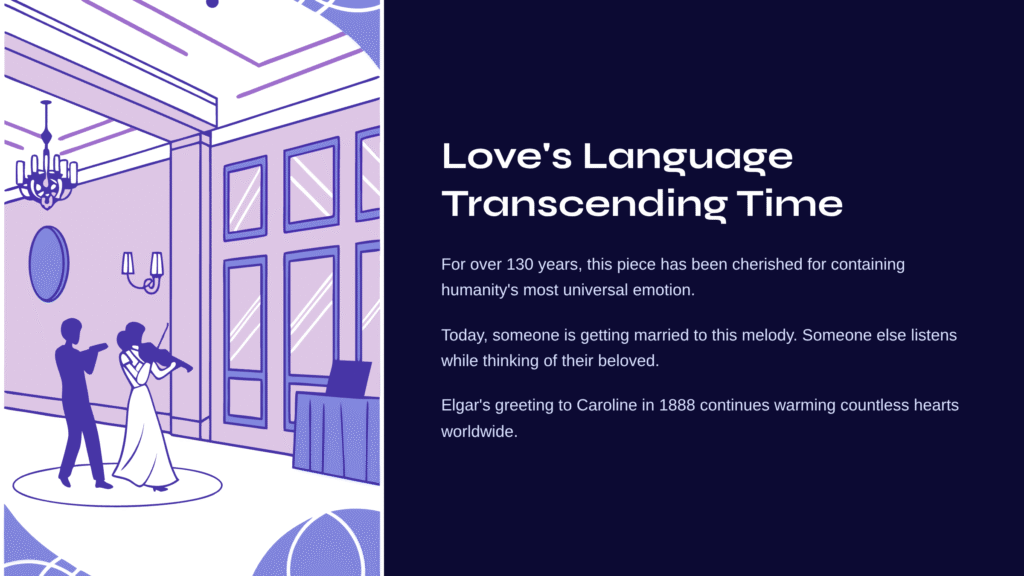
Love’s Language Transcending Time
Why has Salut d’Amour been cherished for over 130 years? Perhaps because it contains humanity’s most universal yet precious emotion. Beyond technique or form, it’s perfect proof of how beautiful music can become when one human’s pure love for another is transformed into sound.
Today, somewhere, someone is getting married to this melody, while someone else listens to this music while thinking of their beloved. Elgar’s love’s greeting to Caroline in 1888 continues to warm countless hearts around the world at this very moment.
Isn’t music the most beautiful language that transcends time? And the message of love conveyed through that language will remain by our side forever, adding light to our lives.

Next Journey: Prokofiev’s Turbulent Love
After hearing Elgar’s gentle declaration of love, how about encountering a completely different dimension of love’s story? “Dance of the Knights” from Prokofiev’s ballet suite Romeo and Juliet possesses charm diametrically opposite to Elgar’s Salut d’Amour.
If Elgar’s music sings of love’s sweetness and excitement, Prokofiev paints the weight of fate surrounding love and tragic tension through grand orchestra. From a three-minute miniature to a 40-minute major ballet suite, from personal confession to global drama—where could we find a more perfect contrast?
Particularly, the intense and imposing rhythm of “Dance of the Knights” creates a stark contrast to the elegant melody of Salut d’Amour, serving as a perfect example of how diverse the faces of love can be in music.



